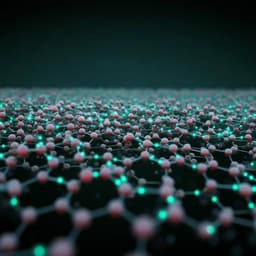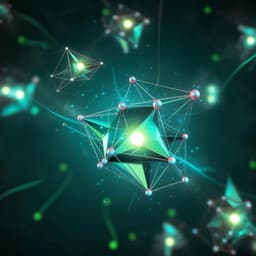
Physics
Quantum spin liquid candidate as superior refrigerant in cascade demagnetization cooling
X. Liu, Y. Gao, et al.
Explore the groundbreaking research by Xin-Yang Liu and colleagues, revealing how quantum spin liquids offer exceptional cooling effects and enhanced magnetocaloric performance, potentially revolutionizing refrigeration technologies in space and quantum applications.
~3 min • Beginner • English
Introduction
Magnetocaloric effect (MCE) enables magnetic materials to undergo significant temperature changes under applied fields and underpins adiabatic demagnetization refrigeration (ADR). Conventional ADR predominantly uses dilute paramagnetic salts, which limits volumetric cooling power and thermal conductivity at low temperatures. Strongly interacting magnets typically order and lose cooling power at higher temperatures. Quantum spin liquids (QSLs), however, avoid long-range order due to strong frustration and quantum fluctuations, retaining large low-temperature entropies, particularly near quantum critical points (QCPs). The authors propose extending coolants from paramagnetic salts to QSL candidates and designing demagnetization processes that exploit quantum critical refrigeration (QCR). They posit that combining QCR with ADR in a cascade can pump entropy from ADR to QCR during demagnetization, enhancing cooling power and reaching lower temperatures. Real materials with moderate critical fields, such as YbAlO3 (YAO, a Tomonaga–Luttinger liquid chain) and Na2BaCo(PO4)2 (NBCP, triangular-lattice QSL candidate), offer practical routes to superior magnetocaloric performance.
Literature Review
The work builds on a century of MCE and ADR development and their applications in space astronomy and cryogen-free sub-Kelvin cooling. Prior studies have established enhanced MCE near QCPs, diverging magnetic Grüneisen parameters near criticality, and cooling through quantum criticality in various systems, including spin chains and frustrated magnets. Traditional ADR salts follow T/B scaling and exhibit Schottky anomalies that limit base temperatures and cooling capacities. Previous reports on frustrated magnets and low-dimensional spin systems have indicated large low-energy density of states and strong MCE, suggesting QSLs as promising candidates. This study leverages these insights, comparing frustrated (triangular and kagome) versus unfrustrated (square) Heisenberg models, and integrates knowledge of ADR salt thermodynamics with tensor-network simulations to propose a cascade QCR–ADR architecture.
Methodology
Models: The spin systems are modeled by a Heisenberg Hamiltonian with nearest-neighbor (J) and next-nearest-neighbor (J') couplings and Zeeman term: H = J Σ⟨ij⟩ Si·Sj + J' Σ⟨⟨ij⟩⟩ Si·Sj − B Σi Szi. Highly frustrated triangular-lattice Heisenberg (TLH) with J'/J = 0.1 (putative QSL regime) and kagome-lattice Heisenberg (KLH) models are compared to unfrustrated square-lattice Heisenberg (SLH). Polarization field Bc (full spin polarization) exists due to U(1) symmetry; simulations are tuned so Bc = 1 T across models for fair comparison.
Computations: Ground-state magnetization curves and polarization fields are determined by density matrix renormalization group (DMRG) on finite cylinders (width up to 6), with bond dimensions D = 200–400 ensuring machine-precision truncation in the high-field region. Finite-temperature thermodynamics, especially magnetic entropy S(T,B), are computed with thermal tensor network methods: LTRG for 1D Heisenberg antiferromagnetic chain (HAFC) and XTRG for 2D models (SLH, TLH, KLH). LTRG constructs ρ(β) via Trotter–Suzuki decomposition and bilayer formalism to obtain Z(β) and S(β). XTRG represents H as an MPO, builds ρ(τ) by series expansion at high T, and reaches low T via repeated squaring (exponential cooling in β), then evaluates Z and S from the thermofield double representation. Up to 500–600 bond states are retained, yielding truncation errors ~1e−10 down to ~100 mK on cylinders of width 4–6 near the QCP.
ADR salt thermodynamics: Magnetic entropies of ADR salts (Ce2Mg3(NO3)12·24H2O, CMN, S=1/2; and CrK(SO4)2·12H2O, CPA, S=3/2) are computed using the paramagnetic entropy formula S/R = x coth x − (2S+1)x coth[(2S+1)x] + ln[sinh((2S+1)x)/sinh x], with x = g μB B / (2 kB T), including residual spin–spin interactions via an effective field Beff = sqrt(B2 + b(T)2). Empirical parameters fitted to experimental data: CMN b0 = 0.003 T; CPA b0 = 0.0841 T, T0 = 0.0836 K, α = 0.7973. Phonon contributions are neglected at sub-Kelvin temperatures. The Schottky anomalies set practical low-T limits (FAA ~30 mK, CPA ~10 mK, CMN ~1.5 mK).
Cascade refrigeration design: A two-stage system is proposed: an upper QCR stage (quantum magnet near Bc) and a lower ADR salt stage. Both stages are enclosed in a magnet with peak field Bi = 4 T and connected to a 3–4 K heat sink via a heat switch; a second switch connects the stages. During demagnetization from Bi to Bc, the stages are thermally linked; the QCR cools faster and pumps entropy from ADR to QCR. Below Bc, the interstage switch is opened; ADR continues to the target working T (Tw) while QCR acts as a thermal guard. Two combination modes are considered: X mode (stoichiometric 1:1, Smean = (SQCR + SADR)/2), and M mode (isovolumetric, QCR-dominant, Smean ∝ SQCR).
Real-material inputs: Experimental thermal data for YbAlO3 (YAO; 1D TLL with multi-spinon continuum; Bc ≈ 1.1 T) and Na2BaCo(PO4)2 (NBCP; triangular-lattice QSL candidate; Bc ~ 1 T) are used to construct S(T,B) for the QCR stage and assess cascade performance with CMN and CPA as ADR salts. Magnetic Grüneisen parameter behavior is analyzed qualitatively to interpret divergence near QCP (finite Bc) versus near zero field for ADR.
Key Findings
- Frustrated QSL models (TLH, KLH) exhibit substantially larger magnetic entropy near the polarization QCP (Bc = 1 T) than unfrustrated SLH and ADR salts, enabling deeper adiabatic cooling (lower TM) and larger isothermal entropy changes at very low T as B decreases from 4 T to 1 T.
- The magnetic Grüneisen parameter diverges near finite Bc for QCR coolants, producing steep temperature drops absent in ADR salts (which diverge near B → 0).
- Magnetothermal pumping: When QCR and ADR stages are thermally coupled during demagnetization (B ≥ Bc), significant entropy is pumped from ADR to QCR, boosting ADR cooling capacity.
- Model-based enhancements (Bi = 4 T): For TLH coolant, entropy pumping reaches ΔSx ≈ 0.2 R ln 2 (Ti ≈ 1.6 K, X mode) and ΔSM ≈ 0.4 R ln 2 (Ti ≈ 2.2 K, M mode), exceeding SLH. Corresponding additional adiabatic temperature drops at Bi are ΔTx ≈ 126 mK and ΔTM ≈ 307 mK (for Ti ≈ 2 K). Relative drops: δTx ≈ 25.2% and δTM ≈ 61.4% versus the ADR-only TB ≈ 500 mK under the same conditions.
- Real-material coolants: YAO and NBCP both yield maximal entropy pumping ΔSM ≈ 0.8 R ln 2 in M mode. For NBCP–CPA (base T1 = 3 K), ΔSM ≈ 0.65 R ln 2 leads to an increment rate >400% near Tw = 20 mK. Enhancements with CMN (base 1.5 K) and CPA (base 3 K) increase as Tw decreases because ΔS1 of ADR falls near its Schottky peak while ΔSM remains constant.
- Cooling capacity and hold time: For NBCP–CPA, X mode (similar masses), Tw = 50 mK, T1 = 3 K, hold time increases from 21.05 h/mol (ADR-only) to 28 h/mol (cascade), +33.3%. In M mode, hold time increases to 47.2 h/mol, +124%. At Tw = 30 mK (T1 = 3 K) the hold time rises from 8.05 h/mol to 25.4 h/mol, >215% increment. For NBCP–CMN (T1 = 1.5 K) reaching Tw ≈ 15 mK, hold time can be extended by up to ~25%.
- Thermal guarding: The upper QCR stage cools to intermediate temperatures Tx or TM (about 5–15 × Tw), reducing parasitic heat on the ADR stage. Under a 5 µW load, YAO and NBCP samples remain below 1 K for >50 h from a 500 mK base per mole coolant.
- Efficiency: The cascade’s effective efficiency exceeds conventional ADR (which is bounded by ~Tw/T1) because ADR in the cascade rejects heat to both T1 and Tx/M, and quantum magnets possess large specific heats, improving η.
Discussion
The study addresses the challenge of achieving lower working temperatures and higher cooling power from relatively high base temperatures (3–4 K) without liquid helium by leveraging quantum criticality in frustrated quantum magnets. The divergent magnetic Grüneisen parameter at finite Bc in QSL candidates yields strong cooling around the QCP, while ADR salts are most effective near zero field. Thermal coupling of these complementary regimes during demagnetization pumps entropy from ADR to QCR, enhancing ADR’s low-temperature entropy budget and enabling deeper cooling and longer hold times. Model simulations (TLH and KLH) and analyses based on realistic materials (YAO, NBCP) demonstrate large entropy pumping (up to ~0.8 R ln 2), significant additional temperature drops, and substantial increases in hold time and efficiency. The QCR stage also functions as an effective thermal guard, stabilizing intermediate temperatures and reducing parasitic loads. These findings validate the proposed cascade demagnetization architecture and highlight frustrated low-dimensional magnets as superior magnetocaloric materials for space instrumentation and quantum technologies.
Conclusion
This work proposes and validates a cascade demagnetization refrigeration scheme that combines quantum critical refrigerants (frustrated QSL candidates) with conventional ADR salts. Thermal tensor network simulations of kagome and triangular Heisenberg models reveal enhanced MCE near polarization QCPs. When integrated with ADR salts, magnetothermal entropy pumping substantially increases cooling capacity, lowers achievable temperatures, and extends hold times. Analyses of realistic compounds YbAlO3 and Na2BaCo(PO4)2 confirm giant enhancements, including >200–400% capacity gains under practical operating conditions. The approach improves efficiency and provides thermal guarding, offering a viable helium-free path to sub-100 mK refrigeration for space and quantum applications. Future work should experimentally implement the cascade architecture, optimize material combinations and volume fractions, explore other frustrated or low-dimensional quantum magnets with moderate Bc, and account for lattice/nuclear contributions and engineering of heat switches and thermal links.
Limitations
- The primary evidence is based on simulations and thermodynamic modeling; a full experimental demonstration of the cascade refrigeration with QSL materials is not presented.
- Lattice phonons and nuclear spin contributions are neglected in sub-Kelvin analysis; while often small, they can affect real-world performance and equilibration.
- Effective-field parameterizations for ADR salts rely on empirical fits; deviations in specific samples could alter quantitative outcomes.
- Thermal contact and heat-switch performance, parasitic heat loads, and nonideal adiabaticity in practical setups may reduce the predicted gains.
- The exact nature of low-energy excitations in NBCP and similar QSL candidates remains under active investigation, introducing uncertainty in extrapolations across temperature and field ranges.
Related Publications
Explore these studies to deepen your understanding of the subject.







